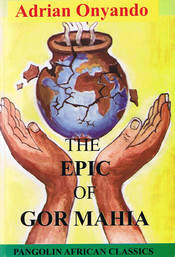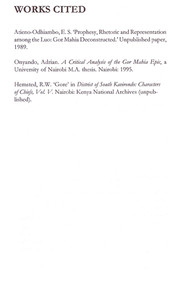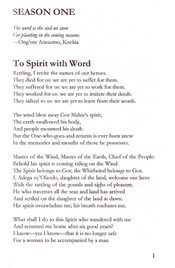Onyando, Adrian The Epic of Gor Mahia
Nairobi, Kenya: Pangolin Publishers, 2005. Originally published in 2003. 228 p. ISBN 9966-9819-0-X. Ages 13 and up.
Summary
The subject of this narrative in verse is Gor Mahia, supernatural hero and historic leader of the Luo people. The epic begins with this legendary hero’s grandfather, then celebrates Gor Mahia’s trials and triumphs, and ends with Gor Mahia’s productive wisdom juxtaposed against the destructive force of modern politicians.
Gor Mahia was born to the ruling family of the Kanyamwa around the first half of the nineteenth century. He faced many hardships in his young life, including exile from home due to his stepbrothers’ hostility. While in exile he acquired many skills in leadership and magic. The commonly held belief is that it was under the tutelage of his maternal and paternal grandparents that he learned magic, which he later used to outmaneuver his political opponents and become the Ruoth (Chief) of the Kanyamwa. Gor Mahia became a leader at a time when the British were consolidating their power in the East African colony. One of their strategies was to appoint powerful leaders as paramount chiefs, who would then help administer the minor chiefdoms. Although Gor Mahia rose to the position of paramount chief under British rule, he never forgot his African heritage.
The British were in awe of his charisma and ability to command respect both from the people and the colonial government. This was a remarkable feat, given the political climate at the time:
The white man wrote down about Gor,
“This is a wizard, pure and simple—
A genius too, he could be:
Probably, no man has ever been so many things;
…………………………………..
And certainly no man has ever had affinity
With so many ages, races and species.” (138)
Commentary
The Epic of Gor Mahia is an account of historical events whose effects still reverberate in the lives of the Kenyan people, especially among the Luo. Its major strength lies in the use of folklore as a stylistic feature. The poetic rhythm of each stanza suggests Luo traditional music, which held a central place in the lives of the people. The author’s use of metaphor and symbolism is evocative of the rich language employed by elders and storytellers in traditional African society.
Grandson to Ogalo
Let me rattle for you the gourd
You refused to be happy with the mob of chiefs
For no white man made you a chief:
You were a chief before the D.C.’s grandmother was wooed.
You refused the white man’s gown and blankets
………………………………………………..
You never took off your royal leopard skin dress,
………………………………………………….
Let me sing, I, daughter of the people
Gor refused to marvel at what was not ours; (162)
The glossary of Luo terms is interesting because it further defines the cultural setting of the story. For example, Lolwe is the Luo name for Lake Victoria, among other regional names; and nyametho is the name of a “comet seen once in a lifetime, that is, after 80-100 years” (218-19). The Epic of Gor Mahia is an important work that can provide high school classes with powerful topics for discussion in literature, social studies, history, and intercultural studies.
Adrian Onyando researched the life and achievements of Gor Mahia for over a decade, and it was the subject of his Master’s thesis at the University of Nairobi. The 2005 edition is a revised version that includes new episodes and incorporates readers’ suggestions.
Others Kenya Pangolin Publishers Ltd | |    |





